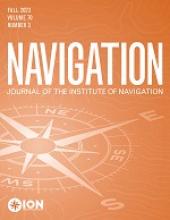Research ArticleOriginal Article
Open Access
Mitigation of Global Navigation Satellite System Cycle Slips Due to Scintillation Using Radio Backpropagation
Brian Breitsch and Jade Morton
NAVIGATION: Journal of the Institute of Navigation September 2023, 70 (3) navi.593; DOI: https://doi.org/10.33012/navi.593
Brian Breitsch
Smead Aerospace Engineering Sciences, University of Colorado, Boulder, Colorado, United States
Jade Morton
Smead Aerospace Engineering Sciences, University of Colorado, Boulder, Colorado, United States

REFERENCES
- ↵
- Banville, S.,
- Langley, R.,
- Saito, S., &
- Yoshihara, T.
- ↵
- Breitsch, B.
- ↵
- Breitsch, B.,
- Morton, Y. T.,
- Rino, C., &
- Xu, D.
- ↵
- Carrano, C. S.,
- Groves, K. M.,
- Caton, R. G.,
- Rino, C. L., &
- Straus, P. R.
- ↵
- de Oliveira Moraes, A.,
- da Silveira Rodrigues, F.,
- Perrella, W. J., &
- de Paula, E. R.
- ↵
- Ghafoori, F., &
- Skone, S.
- ↵
- Humphreys, T. E.,
- Psiaki, M. L.,
- Ledvina, B. M.,
- Cerruti, A. P., &
- Kintner, P. M.
- ↵
- Myer, G. T., &
- Morton, Y. T.
- ↵
- Rino, C.
- ↵
- Rino, C.,
- Breitsch, B.,
- Morton, Y.,
- Jiao, Y.,
- Xu, D., &
- Carrano, C.
- ↵
- Rovira-Garcia, A.,
- Juan, J. M.,
- Sanz, J., &
- Gonzalez-Casado, G.
- ↵
- Sokolovskiy, S.,
- Schreiner, W.,
- Rocken, C., &
- Hunt, D.
- ↵
- Vadakke Veettil, S.,
- Aquino, M.,
- Marques, H. A., &
- Moraes, A.
- ↵
- Wang, Y.,
- Breitsch, B., &
- Morton, Y. T. J.
- ↵
- Xu, D.
- ↵
- Xu, D.,
- Morton, Y. J.,
- Rino, C. L.,
- Carrano, C. S., &
- Jiao, Y.
In this issue
NAVIGATION: Journal of the Institute of Navigation
Vol. 70, Issue 3
Fall 2023
Mitigation of Global Navigation Satellite System Cycle Slips Due to Scintillation Using Radio Backpropagation
Brian Breitsch, Jade Morton
NAVIGATION: Journal of the Institute of Navigation Sep 2023, 70 (3) navi.593; DOI: 10.33012/navi.593
Jump to section
Related Articles
Cited By...
- No citing articles found.






